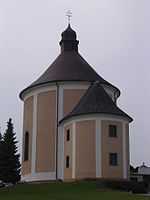Perg
From Wikipedia, the free encyclopedia
| Perg | |
|---|---|
 Perg | |
| Coordinates: 48°15′1″N 14°38′1″E / 48.25028°N 14.63361°ECoordinates: 48°15′1″N 14°38′1″E / 48.25028°N 14.63361°E | |
| Country | Austria |
| State | Upper Austria |
| District | Perg |
| Government | |
| • Mayor | Anton Froschauer (ÖVP) |
| Area | |
| • Total | 26.44 km2 (10.21 sq mi) |
| Elevation | 250 m (820 ft) |
| Population (1 January 2013)[1] | |
| • Total | 8,020 |
| • Density | 300/km2 (790/sq mi) |
| Time zone | CET (UTC+1) |
| • Summer (DST) | CEST (UTC+2) |
| Postal code | 4320 |
| Area code | 07262 |
| Vehicle registration | PE |
| Website | www.perg.at |

The church of the Calvary in Perg.
Perg is a city in the Austrian state of Upper Austria, capital of the district of the same name.
History
Originally in the eastern part of the Duchy of Bavaria, Perg belonged to Austria from the 12th century on. In 1269 it received commercial privileges from King Ottokar II of Bohemia, and from 1490 it was part of the Principality of Austria on the Ems. Autonomous from 1542, it was occupied several times during the Napoleonic Wars.
Main sights
- Einhorn, a large unicorn sculpture inspired to the city's coat of arms.
- Seifensiederhaus (workshop and home of a soap boiler), built in 1563.
- The Late Baroque Kalvarienbergkirche (Church of the Calvary Hill, 1734–1735)
- Pranger (pillory), a column in the main square of the city, built in 1587.
- Steinbrecherhaus (home of mill-stone workers), a little house in old quarries of Perg with original furnishing, built in 1802
References
This article is issued from Wikipedia. The text is available under the Creative Commons Attribution/Share Alike; additional terms may apply for the media files.